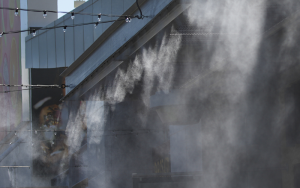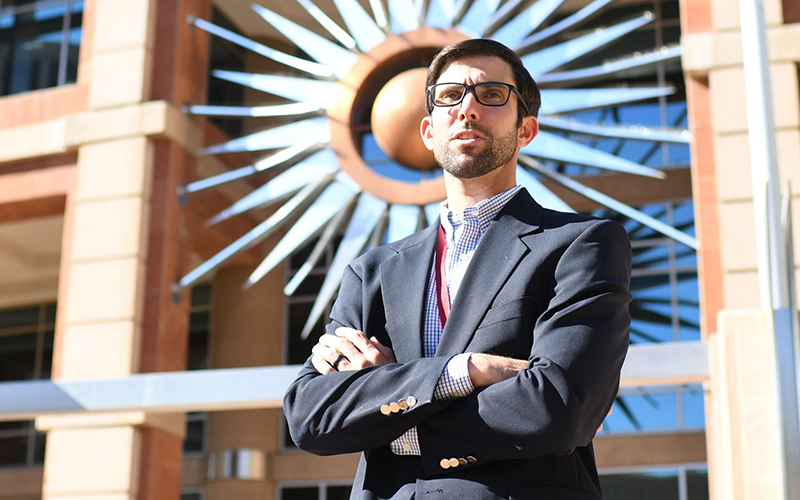
As world leaders gather in Sharm el-Sheikh, Egypt, to discuss global climate policy at the 27th annual UN climate conference, Arizona leaders are working on the implementation of climate policy across the state. (Photo by SIPA PRESS/Shutterstock)
PHOENIX – Stark words greeted the leaders of nearly 200 countries who have gathered in Egypt this month to discuss climate change, policy and action at the United Nation’s annual conference.
“We are on a highway to climate hell with our foot still on the accelerator,” U.N. Secretary General António Guterres told delegates as COP27 opened Nov. 6 in the resort city of Sharm el-Sheikh.
“The science is clear,” he said. “Any hope of limiting temperature rise to 1.5 degrees (Celsius, 2.7 degrees Fahrenheit) means achieving global net zero emissions by 2050. But that 1.5-degree goal is on life support – and the machines are rattling. We are getting dangerously close to the point of no return.”

Average temperatures in Phoenix have increased 4.3 degrees since the 1970s, according to Climate Central. Misters at Tempe Marketplace spray down a walkway on July 18, 2022. (File photo by Troy Hill/Cronkite News)
COP27 comes on the heels of the World Meteorological Organization’s finding that 2022 is the eighth hottest year on record, which will likely result in more extreme heat waves, devastating floods and drought that cost billions of dollars each year and affect millions of people.
Those words resonate with climate experts and some political leaders in Arizona, who are taking their own steps in the absence of a statewide policy. Of particular concern are dwindling water supplies during a megadrought, steadily rising temperatures and the deadly effects of “urban heat islands.”
“I wouldn’t say that we, necessarily as a state, have a particularly sophisticated adaptation plan,” said Katharine Jacobs, who directs the Center for Climate Adaptation Science and Solutions at the University of Arizona. “We would get a lot farther together than we have as individual cities or counties. So it would be great to have state leadership in managing climate risks.”
Arizona does not have a statewide climate action plan, unlike several of the state’s cities, including Phoenix, Tempe, Tucson and Flagstaff. Gov. Janet Napolitano’s administration was working on such a plan, but that changed after Napolitano left office in 2009.
The state does have a climatologist, Erinanne Saffell, who was appointed last year. Arizona’s first state climatologist was appointed in 1974 by then-Gov. John “Jack” Williams.
In an email interview, Saffell said she has met with state agencies, cities, towns, and counties to assist with climate, drought and sustainability with the goal of bringing people together to solve complex problems.
“One useful approach is to mitigate the heat load in cities by providing more shade and other innovative infrastructure practices,” Saffell said.

Extreme heat, increased average overnight temperatures and the “urban heat island” are all issues Arizona leaders have to deal with because of climate change. Misters at Tempe Marketplace spray down a walkway on July 18, 2022. (File photo by Troy Hill/Cronkite News)
In Phoenix and other large cities, the urban heat island effect contributes to overall warmer nighttime lows and daytime highs. This means the temperature in Phoenix is 10 to 15 F degrees higher than in surrounding cities.
“Night temperatures are warmer and there are fewer days below freezing in the state. There are more days that reach 110 degrees or higher,” Saffell said. “Vulnerable populations like people that are older or without housing are more susceptible to heat-related illnesses.”
Saffell said the Phoenix Office of Heat Response & Mitigation is doing a good job of assisting people who must deal with the repercussions of rising heat. The office, which opened in September 2021, was touted as the first publicly funded municipal office of its kind.
Phoenix is one of several Arizona cities with climate action plans; Flagstaff was the first, introducing their plan in October 2018. Phoenix implemented its plan in 2021, addressing issues such as reducing greenhouse gas emissions and improving the city’s resiliency through increased shade and other means.

In September 2021, Phoenix announced David Hondula as the director of the new Office of Heat Response & Mitigation for the city. The office works on strategies to protect people when it is hot and on long-term projects to keep people cool in the future. (File photo by Kevin Hurley/Cronkite News)
“We have two different areas of focus, one we call heat response. Those are the short term strategies that protect people when it’s hot,” said David Hondula, who directs the year-old heat response office. “And the second category of thinking and action is heat mitigation, long term strategies to cool the city, make them more comfortable and improve quality of life with respect to a heat response.”
Heat does not affect everyone equally, according to research posted in 2021 on the website Earth’s Future, areas with lower income levels are more likely to be 7 degrees Fahrenheit warmer than those of higher socioeconomic statuses.
Although not every city may need or can afford a heat office, Hondula said, just having conversations about heat is helpful. This is happening in Tempe, which was the first metro Phoenix city to adopt a climate action plan.
“When they hired a new emergency manager a couple of years ago,” Hondula said, “it was very clear in the job description that working on heat was going to be part of the emergency managers job, which hasn’t been as precisely defined for (the) field of emergency management in general in the past.”
Early this year, Tempe updated its climate action plan to include updated greenhouse gas inventories, policy and infrastructure recommendations and stake-holder focused agendas.
“From my perspective, our city has to be constantly and consistently taking local action when it comes to the environment to ensure that we are really creating a culture in the present that’s helpful for everyone who lives and works here, but also setting things up for future generations, quite honestly,” Tempe Mayor Corey Woods told Cronkite News.
“We want to make sure if there are power outages or situations that arise because of extreme heat conditions that many times affect some people in our community who might come from sort of a lower socioeconomic status. We want to make sure that those folks are taken care of if we have, you know, power power outages, or extreme heat emergencies or that there are places they can go for their basic human needs, if these situations have to arise.”
One way Tempe is dealing with extreme heat emergencies is offering public heat-relief sites during the summer months, which are air-conditioned and have drinking water available.
Woods said that when he took over as mayor in March 2020, the Sustainability and Resilience Committee had been in place for about five years but hadn’t taken substantive action.
“One of the things that was expressed to me by the chair of the sustainability commission, and other people who’ve done a lot of work in that area, you know, ‘Corey, we’ve had a lot of conversations about things, but at some point, the council has to get to a place where they’re advancing actual policy. It can’t just be conversation anymore,’” Woods said.
That has been the message at COP27, which ends Friday. In his opening remarks, Guterres said the choice for humanity was clear: “Cooperate or perish.”
COP27 has a goal of ensuring that all signatories to the Paris agreement implement it, according to a press release from United Nations Climate Change.
The Paris agreement, an international treaty developed at COP21, outlines worldwide climate goals such as limiting global warming to 2.7 degrees Fahrenheit.
“There’s definitely a focus this year on trying to get the implementation plans more clearly articulated, including a focus on how to calculate what loss and damage means associated with climate change and how to finance investments in finding mitigation and adaptation,” said Jacobs at UArizona.
Jacobs, who directed the National Climate Assessment for four years in the Obama administration, said calculating progress countries make towards climate goals is difficult.
“It actually isn’t easy, because obviously developed countries in developed economies, have a very different situation than undeveloped economies,” she said. “Capacities to even measure these things differ by country. Essentially, each country needs to put its own proposal together for how it’s going to monitor its progress.”
Reducing greenhouse gasses and adaptation are two main pieces of climate policy, Jacobs said.
“Many people see those as two separate issues, but in fact, they’re closely connected,” Jacobs said. “Historically, there hasn’t been as much focus on the adaptation part as there has been on managing visions.”

